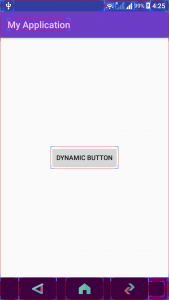Create EditText Programmatically
We know that we can specify Button widget using layout file. But, we can also create a Button programmatically and then add this to a specific View as child, in layout file.
In this tutorial, we will learn how to create a Button widget programmatically in Android, and add this Button to a LinearLayout in layout file.
Code – Create EditText in Kotlin File
A quick snippet of code to create a new Button programmatically in Kotlin Android
val button_dynamic = Button(this) button_dynamic.layoutParams = LinearLayout.LayoutParams(LinearLayout.LayoutParams.WRAP_CONTENT, ViewGroup.LayoutParams.WRAP_CONTENT) button_dynamic.text = "Dynamic Button"
Creating a new Button programmatically at a point in the program requires it to be in UI thread. And also we need the application context to create any new View. Android prevents any View to be created outside the UI thread by throwing a build error.
In this Android Tutorial, we shall learn how to create a Button programmatically and add the Button to a LinearLayout using Kotlin.
activity_main.xml: Following is the activity_main.xml containing an empty LinearLayout to which we shall add the dynamic Button.
<?xml version="1.0" encoding="utf-8"?>
<android.support.constraint.ConstraintLayout xmlns:android="http://schemas.android.com/apk/res/android"
xmlns:app="http://schemas.android.com/apk/res-auto"
xmlns:tools="http://schemas.android.com/tools"
android:layout_width="match_parent"
android:layout_height="match_parent"
tools:context="com.tutorialkart.myapplication.MainActivity">
<LinearLayout
android:id="@+id/ll_main_layout"
android:layout_width="match_parent"
android:layout_height="match_parent"
android:gravity="center"
android:orientation="vertical">
</LinearLayout>
</android.support.constraint.ConstraintLayout> MainActivity.kt: We shall create a new Button with text “Dynamic Button” and add it to the LinearLayout. This addition makes the dynamically created Button to be appended at the end of all child views present in the LinearLayout.
package com.tutorialkart.myapplication
import android.support.v7.app.AppCompatActivity
import android.os.Bundle
import android.view.ViewGroup
import android.widget.Button
import android.widget.LinearLayout
class MainActivity : AppCompatActivity() {
override fun onCreate(savedInstanceState: Bundle?) {
super.onCreate(savedInstanceState)
setContentView(R.layout.activity_main)
val ll_main = findViewById(R.id.ll_main_layout) as LinearLayout
// creating the button
val button_dynamic = Button(this)
// setting layout_width and layout_height using layout parameters
button_dynamic.layoutParams = LinearLayout.LayoutParams(LinearLayout.LayoutParams.WRAP_CONTENT, ViewGroup.LayoutParams.WRAP_CONTENT)
button_dynamic.text = "Dynamic Button"
// add Button to LinearLayout
ll_main.addView(button_dynamic)
}
} Following is the Output with layout bounds :

Conclusion
In this Kotlin Android Tutorial, we have learned to create Button programmatically and add it to layout.
